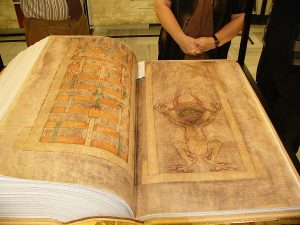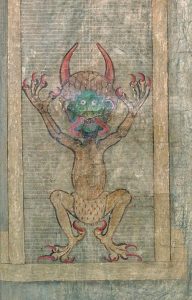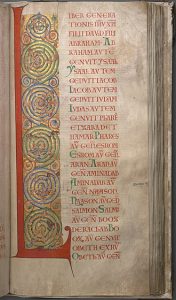
The largest medieval illuminated manuscript in the world is considered to be the Codex Gigas, which in English, translates to Giant Book. This early 13th century tome, however, may be more commonly known as the Devil’s Bible, for it famously contains a mysterious image of the devil.
Below are the top ten interesting facts known about the Codex Gigas:
1)The largest illuminated manuscript of the world measures 3 feet long, almost 2 feet wide, and about 9 inches thick. It weighs around 165 pounds.
2)It is a massive book with currently 310 leaves of vellum (10 are thought missing) and is estimated to have taken 160 skins of calf or donkey to produce the pages needed for the book.
3) Because of the extreme consistency realized in the writing, all through the manuscript, it is believed to have been the work of one individual monk. His name is thought to be Herman the Recluse, who is referenced inside the manuscript. He was from the Benedictine monastery of Podlazice in the Czech Republic.
4)The manuscript was written in the 13th century and is all of Latin. It includes both the Old and New Testaments of the Bible, and works of Josephus: Antiquities of the Jews and The Jewish War. It also contains Etymologiae by Isidore of Seville, Chronicle of Bohemia by Cosmas of Prague, a list of brothers in the Podlazice monastery, and many other shorter texts concerning topics of medicinal value, exorcism, the calendar, and alphabets.
 5)The image of the Devil, with the Heavenly City preceding the eerie portrayal, is found near center, on page 290. He is the only thing seen on the page, and is almost 20 inches high. He is shown crouching and wearing only a loincloth. The small red markings on the piece of clothing are believed to be ermine tails. A symbol for a ruling authority of the time. His raised hands, with four appendages, have wicked claws to match the color of the horns and claws on his feet. His face is green with two tongues dangling from his open mouth of teeth. It is a haunting image and the only one of its kind.
5)The image of the Devil, with the Heavenly City preceding the eerie portrayal, is found near center, on page 290. He is the only thing seen on the page, and is almost 20 inches high. He is shown crouching and wearing only a loincloth. The small red markings on the piece of clothing are believed to be ermine tails. A symbol for a ruling authority of the time. His raised hands, with four appendages, have wicked claws to match the color of the horns and claws on his feet. His face is green with two tongues dangling from his open mouth of teeth. It is a haunting image and the only one of its kind.
6)Besides containing this image, the name the Devil’s Bible relates to the legend surrounding the piece of work. There are various versions of the legend, but ultimately it is said the monk was being punished and needed to complete the book within one night. Unable to do the immense task alone, the monk made a pact with devil in exchange for his soul. He asked the devil for his help. The deal was made, the book completed, and the image of the devil was added to the manuscript in gratitude. In some accounts, the devil himself drew it.
7)Historians studying the manuscript say it took much longer than one night to write. According to the website which houses the Devil’s Bible, they state a scribe could possibly write one column per day for the manuscript. Working this much it would have taken the monk around five years to complete the book. However, this doesn’t allow time for other tasks, or for the creation of the illuminations, which each in themselves, could take days. It is believed to have at least taken over 10 years, but most likely would have taken closer to 20 years. As a work of one monk, it surely was his life’s work.
 8)Although the image of the Devil receives the most attention, the manuscript contains some beautiful and colorful artwork. Most of the illuminations display geometrical designs or connect to plant life. Besides the Devil image, only the portrait of Josephus and a squirrel are noticed to be depicting human or animal life.
8)Although the image of the Devil receives the most attention, the manuscript contains some beautiful and colorful artwork. Most of the illuminations display geometrical designs or connect to plant life. Besides the Devil image, only the portrait of Josephus and a squirrel are noticed to be depicting human or animal life.
9)Besides the name of the monk who created the manuscript, found within the tome itself, nothing more is known about this scribe. From the manuscript’s remarkable design, it’s recognized he was well trained and highly competent, but why he may have created this particular piece or chose to copy the scripts he did is a mystery. And certainly why he chose to draw the devil remains a puzzle. Did he sell his soul to him?
10)The manuscript is currently on display at the National Library of Sweden in Stockholm.

Best of luck with all that you seek! Always Treasure the Adventure!
Photo Credits:
By Michal Maňas – Own work, CC BY 2.5, https://commons.wikimedia.org/w/index.php?curid=3157817
Devil photo credit: By Herman the Recluse (Medieval scribe) – Own work, CC0, https://commons.wikimedia.org/w/index.php?curid=17534736
By Kungl. biblioteket, Attribution, https://commons.wikimedia.org/w/index.php?curid=216504
